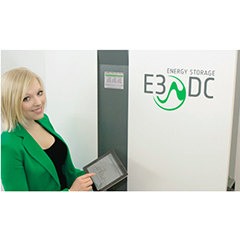State-of-the-art battery performance and the innovative design of power electronics have created commercially viable storage systems. Combined with PV or co-generation at home, E3/DC has created significant volumes in Germany based on professional, industrial production and a new product architecture. Andreas Piepenbrink, founder and CEO, explains the company and product strategy.
Demand for storage: motivation
Energy and power producing products for homes and small businesses were supposed to replace central power plants in the same way as the PC did with central computing in the 80s. Today, PCs, laptops and smartphones have achieved major volumes of the total computing market.
In recent decades, mainly ‘decentralised’ heating systems have been installed at home, and electrical power is still coming from central grids and plants. A paradigm change has been needed to drive a trend called self-consumption. Inflation, the EU debts and visions of personal autonomy have generated product ideas to generate electrical power at home.
After having had a decade of state subsidies according to the EEG law (Feed-in Tariff), private individuals have started to invest in PV as a private power station. Now, combined with automotive and industrial battery technology (lithium-ion), new storage systems are turning up and trying to enable personal electric storage as the future of mainstream building and home efficiency technology.
By maximising the self-consumption at 75%, such systems are able to fix the energy costs for the system lifetime (around 20 years and more). However, mankind and household owners are not used to investing in electric energy generation. But the size of the PV market and the heating market with Co-Generators enables this business as a future volume market more and more.
Even without Feed-in Tariffs, people start to become familiar with the ways of making themselves significantly autonomous and they are willing to invest into long-term reduction of their total energy cost. (The price rises of utility companies [including energy tax and grid costs] have led to 10-12% cost increases in 2012 alone.)
In 2012, E3/DC began series production and sales. In February 2013, 350 units were installed, all of them 100% remote serviceable and connected by internet.
Following Apple’s vision to provide better usability and better functionality, E3/DC products are driven by design and the resulting products follow the functionality of an embedded ‘iPhone’ for energy in the household.
Having now passed the German winter and series production rollout, the learning curve includes a three stage sales and installation process – the performance of few hundred customers. Load and production profiles are known and system performance has been continuously updated by software in all systems. Certified installers in Germany have been trained to handle the system in the best field possible. And new installation procedures have been set up to keep the installation clear and simple, and to not violate the law given for inverters, grid and battery.


























